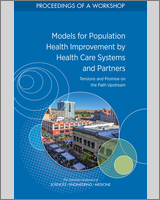NCBI Bookshelf. A service of the National Library of Medicine, National Institutes of Health.
National Academies of Sciences, Engineering, and Medicine; Health and Medicine Division; Board on Population Health and Public Health Practice; Roundtable on Population Health Improvement; Maitin-Shepard M, editor. Models for Population Health Improvement by Health Care Systems and Partners: Tensions and Promise on the Path Upstream: Proceedings of a Workshop. Washington (DC): National Academies Press (US); 2021 May 18.

Models for Population Health Improvement by Health Care Systems and Partners: Tensions and Promise on the Path Upstream: Proceedings of a Workshop.
Show details
***WORKING DRAFT – prepared by Marc Gourevitch with assistance from Alina Baciu to inform discussion at the September 19 workshop Models for Population Health Improvement by Health Care Systems and Partners: Tensions and Promise on the Path Upstream
- WORKSHEET FOR THE PRACTICAL EXERCISE
- Toward Co-Creating Shared Language to Understand and Advance Population Health and Health Equity
- (1)
Identify a rapporteur and a note-taker; annotate the large format version of the diagram, to report group feedback and leave behind for NASEM staff; Keep the handout for your reference, and to continue the conversation after today.
- (2)
Reflect on the presentations and discussion of the day, and the tensions and promise of upstream approaches to advance population health. Considering the Cross Cutting Needs: Workforce, Organizational Structures & Policies, Data & Technology, Metrics and any other considerations, review the diagram and answer the following questions.
- (3)
For comments from the web, email abaciu@nas
.edu.
| What information does the diagram seem designed to convey? | How does this diagram help describe the role of my organization & work? |
| What are its possible uses? | How can I use this in my organization, my work? |
| What changes are needed to make it more useful for specific audiences? | How can I adapt this to describe in my organization, my work? |
References:
Castrucci, B, and J Auerbach. 2019. Meeting Individual Social Needs Falls Short of Addressing Social Determinants of Health. Health Affairs Blog.
Kindig, DA, and G Isham. 2014. Population Health Improvement: A Community Health Business Model That Engages Partners in All Sectors. Frontiers of Health Services Management.
Auerbach, J. 2016. The 3 Buckets of Prevention. Journal of Public Health Management and Practice.
Alderwick, H, and LM Gottlieb. 2019. Meanings and Misunderstandings: A Social Determinants of Health Lexicon for Health Care Systems. Milbank Quarterly.
- Small-Group Exercise: Up/Mid/Downstream Paradigms in Advancing Population Health...Small-Group Exercise: Up/Mid/Downstream Paradigms in Advancing Population Health and Health Equity - Models for Population Health Improvement by Health Care Systems and Partners
- Biographical Sketches of Presenters and Moderators - Models for Population Healt...Biographical Sketches of Presenters and Moderators - Models for Population Health Improvement by Health Care Systems and Partners
- Danio rerio odorant receptor (OR128-6) gene, complete cdsDanio rerio odorant receptor (OR128-6) gene, complete cdsgi|83752593|gb|DQ306063.1|Nucleotide
Your browsing activity is empty.
Activity recording is turned off.
See more...